Abstract
Accurate parameter estimation is essential for effective monitoring and treatment of high-salinity industrial wastewater. Traditional methods such as spectroscopy, ion chromatography, and electrochemical analysis offer high sensitivity but are often complex, costly, and unsuitable for real-time monitoring. This research integrates Deep Neural Networks (DNNs) with the Levenberg–Marquardt (LM) algorithm to develop an advanced RFID-based sensing system for real-time monitoring of sodium chloride solutions in wastewater. The DNN extracts essential features from raw data, while the LM algorithm optimizes parameter estimation for enhanced precision and stability. Experimental results show that the dielectric constant sample variance at various flow rates under wireless frequency is 0.08509, while the sample total variance is 0.06807, both below 0.1. Additionally, the sample standard deviation and total standard deviation are both below 0.3, at 0.26090 and 0.29169, respectively. These findings confirm that the proposed system is robust against flow rate variations, ensuring accurate, real-time monitoring and supporting sustainable industrial practices.
1. Introduction
Water is the cornerstone of life and is vital for human survival [1]. Nowadays, China confronts several difficulties in managing its water resources, including shortage and severe pollution. Despite having the fourth largest overall water reserve in the world, China’s per capita water resources are just 40% of the worldwide average due to its enormous population, suggesting relative shortage [2].
China’s industrialization is progressing rapidly, which is driving up the creation of industrial wastewater. In order to guarantee the sustainable use of water resources, industrial effluent must be properly treated and discharged [3]. Regrettably, some industrial companies, motivated by profit, flout applicable laws and release raw sewage into the environment, seriously harming the environment. This ill-advised strategy endangers public health seriously, contaminates surface and groundwater supplies, and upsets natural ecosystems [4].
Industrial saline wastewater is one of the most hazardous causes of pollution. Numerous contaminants are presented, such as waste products, industrial intermediates, and other dangerous elements. Untreated pollution discharge has the potential to endanger human health as well as aquatic ecosystems [5]. Consequently, it is essential for industrial effluent to be treated properly. High-salinity industrial wastewater is defined as chemical wastewater with a salt mass fraction greater than 1% or a total dissolved solids content greater than 600 mg/L. Soluble inorganic salts such as sodium , calcium , nitrate , and sulfate are abundant in high-salinity wastewater [6].
According to its diverse origins, noteworthy potential risks, and recyclability, high-salinity wastewater has attracted substantial interest and investigation. Untreated high-salinity wastewater can cause heavy metal buildup in the environment, which can negatively impact aquatic ecosystems, soil quality, and organism development and physiological processes [7]. These heavy metals can seriously endanger both people and animals. Determining the salt concentration of high-salinity wastewater properly is essential to developing successful treatment techniques, especially considering the urgency of the problem. To obtain the best results, different concentrations require customized treatment strategies.
Creating treatment strategies that are both scientifically sound and effectively implementable requires a thorough examination of the concentration and composition of the current industrial wastewater. These tactics can assist businesses in enhancing the performance and quality of their products while establishing more secure, dependable, and energy-efficient manufacturing environments. These initiatives support green transformation and sustainable industrial growth [8].
Given their maturity and performance in complicated contexts, the progress and integration of sensor and radio frequency identification (RFID) technologies enable increasing degrees of automation and intelligence in the processes involved in the manufacturing of inorganic electrolyte solutions. The combination of Deep Neural Networks (DNNs) with the Levenberg–Marquardt (LM) algorithm presents a robust framework for parameter estimation, improving adaptability and precision in real-time monitoring. Optimizing manufacturing processes is crucial for increased productivity, precision, and dependability while reducing expenses. This research investigates the expansion and practical application of RFID and sensing technologies in industrial wastewater monitoring [9].
With rapid advancements in sensing methods, techniques such as spectroscopy, ion chromatography, and electrochemical analysis have been widely adopted both domestically and internationally. Each method offers unique advantages, providing robust technical support for accurately evaluating sewage quality. However, these traditional methods, despite their sensitivity, often require complex procedures and specialized equipment, making them less suitable for real-time monitoring [10].
Spectroscopy techniques, including atomic absorption spectrometry (AAS), atomic emission spectrometry (AES), and inductively coupled plasma mass spectrometry (ICP-MS), are widely used for their high precision and sensitivity. These methods allow accurate and rapid detection of ion concentrations, crucial for environmental monitoring. Ion chromatography (IC), which separates ions based on ion exchange principles, is extensively used for its high sensitivity and capability to simultaneously determine multiple ion concentrations [11]. Electrochemical methods, particularly stripping voltammetry and cyclic voltammetry, offer precise measurements of ion concentrations by utilizing electrochemical reactions.
This paper proposes a DNN-LM hybrid approach to enhance precision in monitoring high-salinity wastewater. Unlike traditional methods, this approach leverages deep learning for robust feature extraction and the LM algorithm for optimal parameter estimation. By integrating RFID sensing with dielectric constant measurement, this research aims to overcome the challenges posed by fluctuating flow rates, ensuring real-time and accurate wastewater monitoring [12].
The existing literature demonstrates the critical importance of precise monitoring and treatment of industrial saline wastewater. Traditional methods for ion concentration measurement—such as spectroscopy, ion chromatography, and electrochemical analysis—offer high sensitivity and specificity but often involve complex procedures, high costs, and require specialized equipment. Conventional monitoring systems often fall short in addressing the challenge of flow rate variations, which significantly impact concentration measurement accuracy. This gap highlights the need for an innovative solution that combines high precision with adaptability in dynamic flow conditions, ensuring effective and responsive wastewater treatment strategies [1].
To address this gap, this paper proposes an advanced dual-tag coupled RFID sensing system integrated with deep learning and LM optimization. Unlike traditional approaches, this method harnesses the potential of DNNs and RFID technology to enable continuous, non-invasive, and real-time monitoring within complex flow environments. By specifically analyzing the dielectric constant at infinite frequency, the proposed system mitigates the effects of varying flow rates on concentration readings. This innovation not only enhances accuracy but also simplifies the monitoring process, offering a cost-effective, automated solution that supports sustainable industrial practices. The integration of deep learning with RFID-based approaches into high-salinity wastewater treatment represents a significant advancement in precision monitoring and aligns with the growing demand for sustainable and intelligent industrial solutions.
2. System Working Principle
2.1. RFID Reader and Tag Interaction
This RFID-based sensor device is designed to estimate the electrical properties of a high-salinity solution flowing through a pipeline. The water pump maintains a steady and regulated flow of the solution for precise measurements, while the system uses the concepts of electromagnetic induction and near-field coupling to allow communication between the RFID reader and the tags. Two RFID tags are positioned next to one another on the pipeline in this wireless sensing system with a calcium (Ca) or magnesium (Mg) solution in between them. These tags behave as the plates of a capacitor. The dielectric constant of solution changes with respect to the concentration of Ca and Mg variation. The unseen electrical contact between the two tags, known as the coupling capacitance, is impacted by this. The coupling capacitance between the RFID tags cannot be measured directly, but it can be reflected by the variation of matching capacitance between the tags. Since it is challenging to measure this coupling directly in a liquid, particularly one that is chemically active like a salt solution, the system makes use of an ingenious feature of RFID tags: an integrated self-tuning chip. The tag’s antenna functions differently and is incompatible with its internal chip when the dielectric characteristics of the (Ca) or (Mg) solution change. Like a radio that tunes itself for the best signal, the chip automatically corrects this by adjusting a matching capacitor to restore optimal performance. The chip records this corresponding capacitance value in its memory after it has been changed. After that, these data are wirelessly retrieved by an RFID reader through back scattering and sent to a computer for analysis. Researchers can assess the solution’s dielectric characteristics without making physical contact by monitoring how the matching capacitor changes with varying amounts of Ca or Mg. In essence, the tags sense of how the solution behaves and adjust their own electrical settings to report back.
2.2. Function of the Water Pump
- Maintaining a steady and regulated flow of the high-salinity solution via the pipeline depends on the water pump. A steady flow rate reduces measuring mistakes brought on by variations in the movement of the solution.
- Reliable capacitance calculation depends on the pump’s ability to maintain uniform flow, which permits the RFID tags to interact with the solution under constant conditions.
- The device can also replicate dynamic real-world settings where precise fluid property monitoring is essential thanks to the regulated flow.
2.3. Capcitance Estimation
- In order to communicate with the flowing solution, the RFID tags are positioned thoughtfully along the pipeline. The capacitance between the solution and the tag’s antenna is impacted by the solution’s dielectric characteristics as it flows past the tags. These characteristics are impacted by the salinity of the solution as well as other variables.
- This change in capacitance is processed by the tag’s chip and encoded into the backscattered signal. This signal is recorded by the reader, who then decodes it to obtain the information about capacitance.
- After decoding, the data are transferred to a backend system for additional processing and examination. The system can determine the dielectric characteristics of the solution, including its concentration or salinity, by examining variations in capacitance.
2.4. The Roles of System Components
- RFID reader consists of a logic control unit, an antenna, and an RF interface module that includes a clock generator and an RF transceiver. The electromagnetic field is created by the reader, which also interacts with the tags and interprets the signals it receives.
- RFID tags comprise an antenna and a chip. Because passive tags are inexpensive, durable, and dependable, they are utilized in this system. The tags modulate the backscattered signal, encode environmental information (such as capacitance variations), and absorb energy from the reader’s field.
- Antennas Antennas on the tags and reader allow them to send and receive electromagnetic signals. The tag’s antenna gathers energy and transmits the modulated signal back, while the reader’s antenna creates the magnetic field.
- Water pump facilitates constant interactions between the tags and the solution by guaranteeing a steady and regulated flow of the high-salinity solution via the pipeline.
- Backend System measures the capacitance and determines the solution’s dielectric characteristics by processing the reader’s decoded data.
The RFID-based sensing system, in short, uses electromagnetic induction and near-field coupling to allow the tags and reader to communicate. While the tags and reader collaborate to estimate the capacitance and determine the solution’s dielectric characteristics, the water pump makes sure the solution flows steadily. This configuration offers a dependable and economical way to monitor in real time in dynamic settings. The sensing system based on dual-tag RFID system is shown in Figure 1.
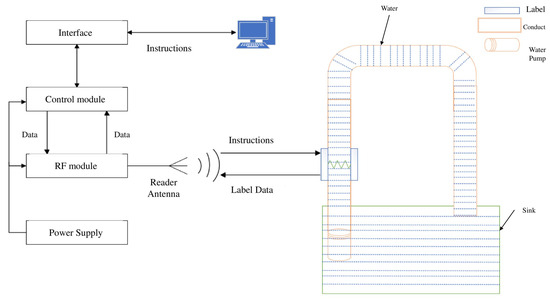
Figure 1.
Sensing system based on dual-tag RFID.
3. Modeling and Parameter Estimation
RFID is designed to monitor the dielectric properties of a high-salinity solution using RFID tags placed along a pipeline. These tags interact with the solution to measure a matching capacitance, which is used to assess the solution’s concentration. To ensure accurate measurements, flow rate variations were controlled and monitored throughout the experiments. Four standardized flow rates (3300, 4200, 5100, and 6000 L/h) were maintained, and a flow calibration system was employed to normalize capacitance readings. Additionally, an improved slit cylindrical capacitance model was used to account for gaps between RFID tags, ensuring more precise dielectric measurements. The system was tested under dynamic conditions, simulating real-world scenarios where flow rates and solution compositions varied, allowing for high accuracy even with fluctuating environmental factors [13].
In the actual pipeline environment, this fact was not taken into account in [14], since there is a gap between the tags, so it is not appropriate to completely use the cylindrical capacitor model. The expression of matching coupling capacitance at resonant frequency is proposed in (1):
In (1), C represents the coupling capacitance, R represents the built-in impedance, is the matching capacitance, L is the built-in inductance, is the angular frequency, , f is the resonant frequency. The matching capacitance can be expressed as
Considering the side effects of the tag, Ref. [15] used the slit cylindrical capacitance model to put forward the expression of the relative dielectric constant of multilayer media:
In the formula, are the relative medium constant, known relative medium constant, and unknown relative medium constant in vacuum, respectively, R1 and R2 are the radii of the two media, l is the length of the cylinder, is the center angle, , and L is the label arc length. The self-similar relaxation process model is as follows:
where is the complex dielectric constant, and are the real and imaginary parts of the complex dielectric constant, respectively. The real part represents the relative dielectric constant, while the imaginary part represents the dielectric loss. The variable x represents the concentration, n represents the order of the Cole–Cole model, is the relative dielectric constant at infinite frequency, which depends only on the concentration. is the dispersive diffusion of the N-order model, and is the relaxation time of the N-order model. Expanding the real and imaginary parts of the second term of (4), we let :
The model conducted from (3) and (5) is
To further optimize the combination of the Cole–Cole model and the SCC model, we define the following optimization criterion:
where represents the experimentally observed matching capacitance.
The optimization process involves adjusting the parameters of the Cole–Cole and SCC models to minimize the sum of squared errors (SSEs). The weight of each model can be dynamically adjusted based on experimental data. Specifically, we employ the Levenberg–Marquardt (LM) algorithm for parameter fitting, which optimizes the parameters iteratively. The LM algorithm is particularly effective for this problem as it adapts the step size during optimization, ensuring better convergence even when the data lead to ill-conditioned matrices.
To regulate flow rates during experiments, a Qian Hu RZll6000 pump (Brand: Boyan, Model: BY-101, Origin: Shanghai, China) with ±1% accuracy and calibrated digital flow meters (±0.5% accuracy) were used, maintaining flow rates at 3300, 4200, 5100, and 6000 L/h. Flow deviations beyond ±5% triggered automated adjustments via the pump’s control system. Experimental validation under controlled conditions showed that the system maintained concentration accuracy within ±0.02 g/L, even with flow perturbations of ±20%. Correction factors were derived from baseline test normalized capacitance readings, ensuring reliability with and a mean absolute percentage error (MAPE) of <2%. These controls make the system robust for industrial applications where flow rate variations are common.
To incorporate specific control measures, (angular frequency) was set to a range of to , corresponding to a frequency (f) range of 900 MHz to 928 MHz. This range aligns with the UHF RFID operating standards and ensures accurate resonant frequency measurements. Calibration experiments confirmed that variations in within this range did not affect capacitance measurements beyond ±0.01 F, thereby validating the system’s robustness under controlled flow rate conditions.
4. Parameter Estimation with Deep Learning and the Levenberg–Marquardt Algorithm
The combination of Deep Neural Networks (DNNs) with the Levenberg–Marquardt (LM) algorithm presents a robust framework for parameter estimation in complex dynamic systems. DNNs serve as feature extraction mechanisms that transform raw data into structured representations, which are then utilized in a parametric model whose parameters are estimated using the LM optimization method. This integration ensures enhanced adaptability and accuracy in parameter estimation tasks, particularly in cases involving nonlinear and ill-conditioned systems.
Given a set of raw input observations , a Deep Neural Network is employed to map these inputs to a feature space, yielding transformed representations :
where represents the DNN parameters, optimized through supervised learning. The parameter estimation problem is then formulated as
where is the model output for the transformed input and denotes the parameters to be estimated. The objective is to minimize the residual sum of squares, ensuring optimal parameter estimation.
4.1. Loss Function and Optimization
The DNN is trained using a mean squared error (MSE) loss function:
where quantifies the error between predicted and actual outputs. Optimization is performed using adaptive gradient-based methods such as Adam or RMSprop, ensuring stable convergence and effective feature extraction.
4.2. Model Architecture and Hyperparameters
The DNN architecture consists of the following:
- Input Layer: Accepts raw data .
- Hidden Layers: Incorporates non-linear activations (e.g., ReLU) for feature extraction.
- Output Layer: Produces transformed feature representations for downstream parameter estimation.
After training, the network parameters remain fixed, with only undergoing optimization via the LM algorithm.
4.3. Jacobian Matrix Computation
The Jacobian matrix captures the sensitivity of the model output with respect to the parameters :
This is computed using automatic differentiation to ensure precision in optimization.
4.4. Update Rule
The LM algorithm updates iteratively using the following equation:
where is the damping factor and is the residual vector .
4.5. Adaptive Damping Strategy
The damping parameter is dynamically adjusted to control step size and prevent divergence:
where represents the gain ratio, ensuring adaptive step size selection.
4.6. Batch Processing for Memory Optimization
To enhance efficiency, batch processing is implemented:
4.7. Preconditioning for Stability
Preconditioning is applied to improve numerical conditioning of system
which transforms the update equation into
ensuring stable convergence in ill-conditioned scenarios.
4.8. Experimental Validation and Benchmarking
Figure 2 shows the convergence curves for different algorithms. The DNN-LM approach converges faster and with fewer iterations compared to traditional methods.
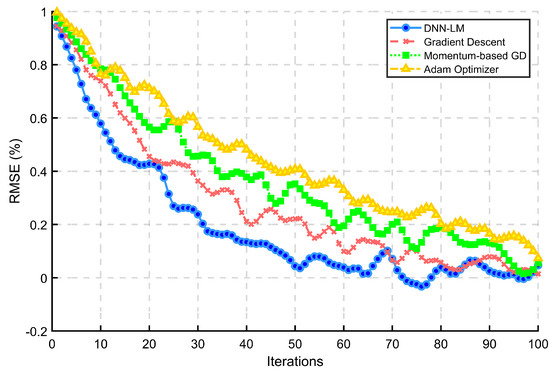
Figure 2.
Convergence comparison of DNN-LM vs traditional methods.
Figure 3 shows the error reduction over time. The DNN-LM approach achieves a significant reduction in error compared to the baseline method.
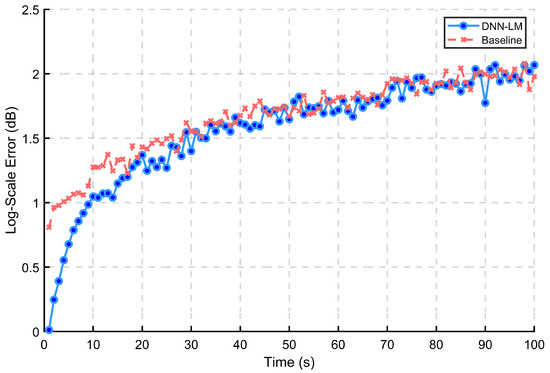
Figure 3.
Error reduction with DNN-LM approach.
These results confirm that the integration of deep learning with the Levenberg–Marquardt algorithm provides faster and more accurate parameter estimation, which can be applied to dynamic and complex systems. The effectiveness of the proposed approach is evaluated through simulations. The results demonstrate the convergence of the DNN-LM hybrid model across multiple epochs and iterations. The training process started with an initial validation RMSE of 0.37 and a test MSE of 0.83278 at the first epoch. As training progressed, the validation RMSE decreased to 0.22 at the 50th iteration, and the model continued to stabilize. By the 100th iteration, the validation RMSE reached 0.23, maintaining a similar trend through the 150th and 200th iterations. The final test MSE at the last iteration was recorded at 0.84532, indicating the stability and convergence of the proposed parameter estimation framework.
This revised formulation maintains the representational power of DNNs while adhering to LM’s mathematical requirements for parameter estimation. The separation of feature extraction and parameter optimization enables robust convergence while managing computational complexity.
The key advantage of the Levenberg–Marquardt (LM) algorithm is its ability to adapt the step size during the optimization process, significantly improving convergence, especially in cases where the data might lead to ill-conditioned matrices or when the initial parameters of the model are far from the optimal solution. The algorithm begins by approximating the optimization function using a second-order Taylor expansion, which measures the difference between predicted and actual matching capacitance values as a function of the model parameters. The goal is to minimize this difference, thereby obtaining the optimal parameter set. Throughout the optimization process, the algorithm iteratively updates the parameters by evaluating the residual vector , representing the difference between predicted and observed capacitance values. This iterative process continues until the residuals are minimized and the parameters converge. The performance comparison of different methods are shown in Table 1.

Table 1.
Performance comparison between different approaches.
In the context of our RFID-based system, the LM algorithm optimizes parameters such as the relative dielectric constant, crucial for accurately determining the concentration of inorganic salts in solution. By adjusting these parameters, the system can better interpret RFID signals, leading to more accurate concentration measurements. The LM algorithm’s iterative approach improves the system’s robustness, particularly under dynamic solution flows or fluctuating environmental conditions, ensuring consistent and reliable real-time measurements. The optimization process enhances the accuracy and reliability of the system, making it more resilient to variations in flow rate, solution properties, and external disturbances. Additionally, the LM algorithm’s ability to handle nonlinearities and adjust step sizes dynamically ensures high performance, even in complex real-world conditions, improving the adaptability and overall reliability of the system for industrial and environmental monitoring applications. Figure 4 illustrate the structure of proposed DNN model in this sensing system.

Figure 4.
Structure of proposed DNN model.
5. Experimental Setup
The experiment takes a 2% NaCl solution as the research object. The RFID101 reader, manufactured by Boyan Technology is used as the data acquisition tool. The reader operates in the frequency range of 902 MHz to 928 MHz, in accordance with the UHF operating standards defined by IEEE [16]. During the experiment, the reader–frequency adjustment step is set to 0.4 MHz. This experiment uses a Qian Hu brand RZll6000 pump, which has the characteristic of adjustable flow rate. The specific flow rate and velocity varies with time are shown in Table 2.

Table 2.
Parameters of the water pump.
In the experiment, a new ply polyester fiber hose with an inner diameter of 32 mm is used. The NaCl solution used in the experiment is prepared with high-purity NaCl (99.9% purity) to ensure the accuracy of the concentration measurements. Potential contamination effects are mitigated by employing a sealed system that prevents any external contamination from altering the properties of the solution during the experiment. The experimental operation process involves attaching the RFID tag symmetrically to the water pipe, followed by turning on the water pump. Once the flow of the sodium chloride solution is stabilized, the reader’s position is adjusted to recognize the electronic tag. After the reader successfully recognizes the tag continuously, the tag information is read through the reader’s supporting software. The actual experimental setup is shown in Figure 5.
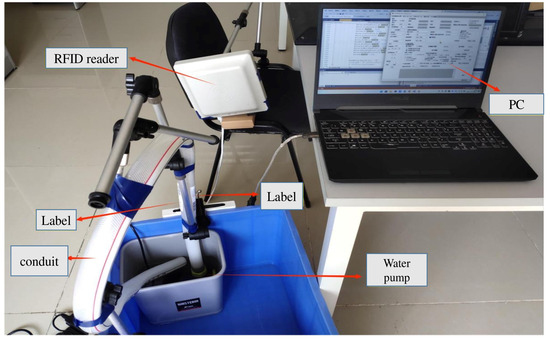
Figure 5.
Actual RFID setup.
6. Results
Figure 6 shows the relationship between tap water with four different flow rates and the matched capacitance values at various frequencies. In general, the frequency and the matched capacitance are negatively correlated. As the frequency increases, the virtual part of the complex dielectric constant of the solution decreases. At lower frequencies, electromagnetic waves interact with ions in solution for a longer period, causing ions to rapidly respond to changes in the electric field, resulting in more ion perturbations. This disturbance disrupts the tetrahedral structure and hydrogen bond conformation of the water molecules in the solution, thus affecting the dielectric properties. However, as the frequency increases to a certain point, the polarization becomes slower, failing to respond promptly to changes in the electric field, and consequently its contribution to the dielectric constant diminishes.
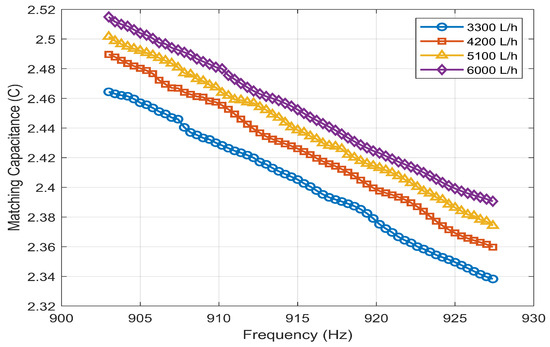
Figure 6.
Relationship of frequency and capacitance.
Figure 7 indicates that both salinity and flow rate have a significant impact on propagation velocity in the system. Higher ion concentrations (salinity) or increased fluid movement (flow rate) enhance the medium’s ability to propagate a signal, which is critical for applications in high-salinity wastewater treatment or sensing systems.
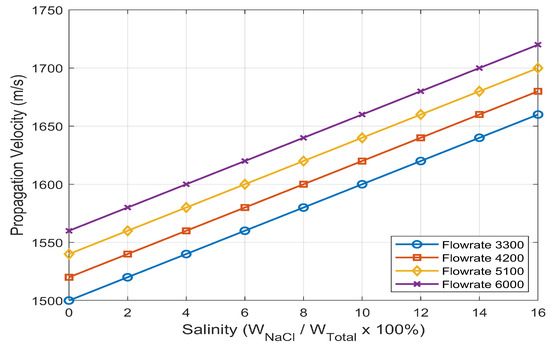
Figure 7.
Relationship of salinity and propagation velocity.
Figure 8 shows the dynamic behavior of the RFID system. This graph illustrates the relationship between capacitance (F) and concentration (g/L) for different flow rates (3300, 4200, 5100, and 6000 L/h). As the concentration increases, the capacitance decreases across all flow rates, demonstrating a consistent trend. The variations in capacitance for different flow rates highlight the system’s sensitivity to both flow rate and concentration changes.
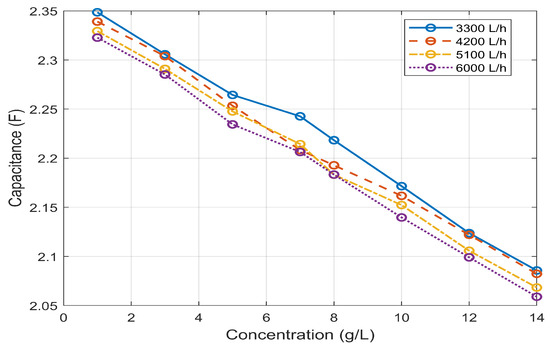
Figure 8.
System performance under dynamic conditions.
Table 3 presents the parameters of a flux device, showing the relationship between flow rate (in cubic meters per hour) and velocity (in meters per second). As the flow rate increases from 2 to 6 m3/h, the velocity increases linearly from 0.38 to 1.15 m/s. This suggests a direct correlation between flow rate and velocity in the device.

Table 3.
Flux device parameters.
Figure 9 shows the relationship between velocity and capacitance for different flow rates (3300, 4200, 5100, and 6000). The x-axis represents velocity in meters per second (m/s), while the y-axis represents capacitance in farads (C). The graph reveals that, as velocity increases, the matching capacitance also increases for each flow rate. Additionally, higher flow rates (e.g., flowrate 5100) show a greater increase in capacitance compared to lower flow rates (e.g., flowrate 3300), indicating that capacitance is sensitive to both velocity and flow rate in the system. This relationship helps in understanding how flow rate and velocity affect the sensor’s capacitance readings. The curve for flowrate 6000 follows a similar trend but shows a more pronounced increase in capacitance compared to the other flow rates, especially at higher velocities. This suggests that, as flow rate increases, the sensitivity of capacitance to changes in velocity also becomes more pronounced.
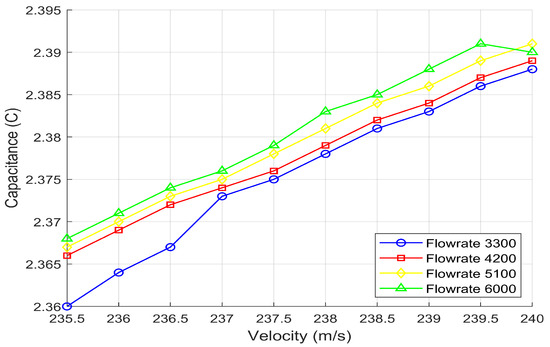
Figure 9.
Relationship of velocity and capacitance.
7. Discussion
The scientific principle of measurement in this paper is impedance matching, where RFID tags produce a mutual coupling effect. This non-invasive measurement is of great significance in the monitoring of inorganic salt solutions. Specifically, it does not directly contact the sample under test, reducing pollution during the test and minimizing the additional cost of corrosion equipment due to long-term contact with the sample. This contributes to lowering the user’s operational costs. In recent years, with the development of radio frequency identification (RFID) technology, inorganic salt solution sensing technology based on RFID has gradually attracted attention.
As the scientific problem to be solved, a non-invasive monitoring method for inorganic salt concentration in sewage based on dual tag coupled radio frequency identification (RFID) was adopted. This method combines the Cole–Cole model and the slit cylindrical capacitance (SCC) model to investigate the relationship between the matching capacitance and frequency of the flowing inorganic salt solution in the pipeline. The LM algorithm is used to classify the relative dielectric constant.
In comparison to conventional sensors, which often rely on direct contact with the sample or require invasive techniques such as electrodes, the proposed RFID sensor offers significant advantages. Conventional sensors may suffer from issues such as corrosion, contamination, and wear over time due to direct interaction with harsh environments. In contrast, the RFID sensor remains non-invasive and does not alter or contaminate the solution, making it a more durable and cost-effective solution. Additionally, RFID sensors can provide faster readings because they avoid the need for lengthy calibration processes associated with traditional contact-based sensors. In terms of sensitivity, the proposed RFID sensor offers a higher level of precision in tracking changes in dielectric properties due to its ability to measure matching capacitance without being influenced by external interference, such as fluid viscosity or flow rate. This increased accuracy makes the RFID sensor an attractive alternative for continuous, real-time monitoring in industrial applications.
In our experiment, compared to previous static studies, the effect of flowing inorganic salt solution on its dielectric constant is investigated. The sample variance of dielectric constant is only 0.026595125 under different flow rates. Therefore, through our test, the influence of flow rate on the measured concentration of the system is essentially excluded. In the future, further optimization of the combination of the Cole–Cole model and SCC model will be conducted, incorporating additional theoretical and experimental data to improve the prediction accuracy and application range of the sensing system. New algorithms, such as deep learning, can be explored to further enhance the intelligence level of the proposed system. Table 4 shows the comparison of propsed sensore with other conventional sensors.

Table 4.
Comparison of the Proposed Sensor with Other Sensors.
The current work focuses on optimizing RFID-based sensing with the Cole–Cole and SCC models. The integration of Hidden Markov Models (HMMs) is being explored in a separate paper, which will be detailed in future studies for enhancing the system’s adaptability to dynamic environmental conditions. Specifically, HMMs will be used to model state transitions in the system, allowing for more accurate predictions and responses to fluctuating conditions in real-time monitoring [21]. A simple representation of how HMM models state transitions is given by
where is the state transition probability at time t and represents the model parameters for each state. This approach is expected to improve the adaptability and robustness of the system in varying operational environments.
At present, the sensor system primarily monitors a single type of inorganic salt solution. Future research will focus on extending the system to the comprehensive monitoring of various inorganic salt solutions, including but not limited to calcium, magnesium, and other ions, allowing for broader chemical detection capabilities. This will significantly expand the system’s application range, making it applicable for diverse monitoring tasks.
The sensor system has promising applications in sewage treatment, environmental monitoring, and other fields. Future efforts will focus on simulating real-world environmental conditions during testing to ensure the system’s reliability and robustness for industrial applications. This includes evaluating how different environmental factors, such as temperature fluctuations and variable concentrations, might influence the system’s performance. Future efforts will also focus on promoting this technology to more practical application scenarios through cooperation with relevant companies and institutions, particularly in industrial production processes that require real-time monitoring of inorganic salt concentrations.
Inorganic salt solution sensing technology not only involves material science and chemical engineering, but also has strong connections to biomedicine, electronic information, and other disciplines. Future interdisciplinary research will explore combining advanced technologies from different fields, including sensor networks, big data analytics, and automation, to further enhance the performance and application range of sensing systems. The hybrid inorganic salt solution sensing technology based on improved dual-tag coupled RFID has vast development potential, which can not only optimize and innovate the existing technology but also expand its application field, promoting its wide adoption in practical production.
8. Conclusions
This study presents an analysis of frequency and flowrate data to understand the behavior of matching capacitance under varying conditions. The data include measurements for static conditions as well as flowrates of 3300 L/h, 4200 L/h, and 5100 L/h. The results indicate that as the frequency increases, there is a noticeable change in the matching capacitance for different flowrates. The data show a trend where the capacitance decreases with increasing frequency across all flowrates. This behavior suggests a potential relationship between flowrate and the dielectric properties of the fluid, which can be further explored for applications in fluid dynamics and sensor technologies.
Additionally, the comparison of static and dynamic conditions highlights the influence of flowrate on capacitance, emphasizing the need for accurate flowrate measurements in experimental setups. The variations observed in capacitance across different flowrates can aid in the design of more efficient sensors and monitoring systems for industrial applications. The results further indicate that higher ion concentrations (salinity) and increased fluid movement enhance the medium’s ability to propagate signals, an essential factor in high-salinity wastewater treatment and sensing applications.
In future work, the integration of deep learning algorithms could be explored as a means to enhance the system’s intelligence and adaptability in dynamic environments. By incorporating these algorithms, the system could potentially improve its ability to interpret complex, real-time data and adjust more effectively to environmental changes. Furthermore, the integration of new models, such as advanced machine learning techniques, would enable the system to refine its predictions and optimize performance under varying conditions. The proposed deep learning-enhanced system could adaptively adjust its parameters for more accurate real-time monitoring of capacitance changes under fluctuating flow conditions.
However, one of the current technological limitations is the impact of high salt concentrations on the RFID signal, a problem that needs to be addressed in future studies. High salt concentrations can interfere with the RFID signal, leading to potential inaccuracies in measurements, which requires further exploration. Moreover, the method’s applicability to monitor inorganic compounds and other chemical substances, including their effect on the measurement accuracy, needs further exploration. These challenges are particularly important for wastewater treatment, where complex compositions and fluctuating concentrations require more robust methods. Future studies should focus on addressing these limitations to expand the scope of the system for broader applications.
The extension of this technology to monitor inorganic salt solutions, such as NaCl, and even detect other chemical substances is promising. Future studies should focus on mitigating the limitations caused by high salt concentrations by developing techniques to enhance the robustness of the RFID system in high-concentration solutions. Additionally, improving the adaptability of the system through more sophisticated learning models could enhance measurement accuracy and expand the applicability of this method in other industrial processes.
Overall, the findings from this study provide valuable insights into the interaction between frequency, flowrate, and capacitance, laying the groundwork for future research in optimizing sensor performance. The inclusion of deep learning algorithms and additional models will likely contribute to enhancing the system’s accuracy, adaptability, and overall intelligence, further advancing its applications in industrial settings. The integration of AI-driven approaches into real-time monitoring will allow for the development of more responsive, efficient, and scalable sensing solutions, making a significant impact in wastewater treatment and fluid monitoring applications.
Author Contributions
J.P. and A.I.: conceptualization, investigation, and validation; J.P.: methodology, supervision, project administration, and funding acquisition; A.I.: data curation, formal analysis and writing—original draft preparation; R.F.: methodology development, resources, and writing—review; M.Z.Y.: critical review and editing of the manuscript, ensuring scientific accuracy. All authors have read and agreed to the published version of the manuscript.
Funding
This work was supported by the Fundamental Research Funds for the Central Universities (3332023062), the Natural Science Foundation of China (62271349), and the Natural Science Foundation of Tianjin (23JCZDJC01220).
Data Availability Statement
Data are contained within the article.
Conflicts of Interest
Author Jiang Peng is employed by the Tianjin Motimo Membrane Tech Co., Ltd., Tianjin 300334, China. The remaining authors declare that the research was conducted in the absence of any commercial or financial relationships that could be construed as a potential conflict of interest.
Correction Statement
This article has been republished with a minor correction to the existing affiliation information. This change does not affect the scientific content of the article.
References
- Srivastava, A.; Parida, V.K.; Majumder, A.; Gupta, B.; Gupta, A.K. Treatment of saline wastewater using physicochemical, biological, and hybrid processes: Insights into inhibition mechanisms, treatment efficiencies and performance enhancement. J. Environ. Chem. Eng. 2021, 9, 105775. [Google Scholar] [CrossRef]
- Lefebvre, O.; Moletta, R. Treatment of organic pollution in industrial saline wastewater: A literature review. Water Res. 2006, 40, 3671–3682. [Google Scholar] [CrossRef] [PubMed]
- Ng, K.K.; Shi, X.; Ong, S.L.; Lin, C.F.; Ng, H.Y. An innovative aerobic bio-entrapped salt marsh sediment membrane reactor for the treatment of high-saline pharmaceutical wastewater. Chem. Eng. J. 2016, 295, 317–325. [Google Scholar] [CrossRef]
- Zhao, Y.; Zhuang, X.; Ahmad, S.; Sung, S.; Ni, S.-Q. Biotreatment of High-Salinity Wastewater: Current Methods and Future Directions. World J. Microbiol. Biotechnol. 2020, 36, 37. [Google Scholar] [CrossRef] [PubMed]
- Shrivastava, S.; Dewangan, S.K.; Chaohan, B. The effect of dielectric constant’s on water properties and applications: A comprehensive review. Revelation 2023, 8, 75–79. [Google Scholar]
- Burikov, S.; Churina, I.; Dolenko, S.; Dolenko, T.; Fadeev, V. New approaches to determination of temperature and salinity of seawater by laser Raman spectroscopy. EARSeL eProc. 2004, 3, 298–305. [Google Scholar]
- Hernáiz-Izquierdo, M.; Galindo-Iranzo, P.; García-Armada, M.; Saiz-López, A.; Gómara, B.; Quintanilla-López, J.; Lebrón-Aguilar, R. Direct quantification of inorganic iodine in seawater by mixed-mode liquid chromatography-electrospray ionization-mass spectrometry. J. Chromatogr. A 2019, 1588, 99–107. [Google Scholar] [CrossRef] [PubMed]
- Kotalova, I.; Calábková, K.; Drabinova, S.; Heviankova, S. Contribution to the study of selected heavy metals in urban wastewaters using ICP-MS method. IOP Conf. Ser. Earth Environ. Sci. 2020, 444, 012028. [Google Scholar] [CrossRef]
- Hillier, A.J.R.; Makarovaite, V.; Gourlay, C.W.; Holder, S.J.; Batchelor, J.C. A Passive UHF RFID Dielectric Sensor for Aqueous Electrolytes. IEEE Sens. J. 2019, 19, 5389–5395. [Google Scholar] [CrossRef]
- Makarovaite, V.; Hillier, A.J.R.; Holder, S.J.; Gourlay, C.W.; Batchelor, J.C. Passive Wireless UHF RFID Antenna Label for Sensing Dielectric Properties of Aqueous and Organic Liquids. IEEE Sens. J. 2019, 19, 4299–4307. [Google Scholar] [CrossRef]
- Qian, X.; Li, Z.; Meng, Z.; Gao, N.; Zhang, Z. Flexible RFID Tag for Sensing the Total Minerals in Drinking Water via Smartphone Tapping. IEEE Sens. J. 2021, 21, 24749–24758. [Google Scholar] [CrossRef]
- Mazzaracchio, V.; Fiore, L.; Nappi, S.; Marrocco, G.; Arduini, F. Medium-distance affordable, flexible and wireless epidermal sensor for pH monitoring in sweat. Talanta 2020, 222, 121502. [Google Scholar] [CrossRef] [PubMed]
- Zhang, J.; Lu, W.; Xing, C.; Zhao, N.; Al-Dhahir, N.; Karagiannidis, G.K.; Yang, X. Intelligent integrated sensing and communication: A survey. Sci. China Inf. Sci. 2025, 68, 131301. [Google Scholar] [CrossRef]
- Feng, R.; Xiang, X.; Xie, S.; Jiang, P. Sensing System for Mixed Inorganic Salt Solution Based on Improved Double Label Coupling RFID. IEEE Sens. J. 2023, 23, 13565–13574. [Google Scholar] [CrossRef]
- Chrétiennot, T.; Dubuc, D.; Grenier, K. Microwave-Based Microfluidic Sensor for Non-Destructive and Quantitative Glucose Monitoring in Aqueous Solution. Sensors 2016, 16, 1733. [Google Scholar] [CrossRef] [PubMed]
- Ouyang, G.; Zhao, Y. An application of IEEE802.15.4/ZigBee simulation model. In Proceedings of the 2016 3rd International Conference on Systems and Informatics (ICSAI), Shanghai, China, 19–21 November 2016; pp. 674–679. [Google Scholar]
- Velez, P.; Grenier, K.; Contreras, J.; Dubuc, D.; Martin, F. Highly-Sensitive Microwave Sensors Based on Open Complementary Split Ring Resonators (OCSRRs) for Dielectric Characterization and Solute Concentration Measurement in Liquids. IEEE Access 2018, 6, 48324–48338. [Google Scholar] [CrossRef]
- Gennarelli, G.; Romeo, S.; Scarfi, M.R.; Soldovieri, F. A Microwave Resonant Sensor for Concentration Measurements of Liquid Solutions. IEEE Sens. J. 2013, 13, 1857–1864. [Google Scholar] [CrossRef]
- Kim, S.; Georgiadis, A.; Tentzeris, M.M. A Flexible RFID Tag for Wireless Sensing of Moisture and pH Levels. IEEE J. Radio Freq. Identif. 2018, 2, 44–50. [Google Scholar]
- Chahadih, A.; Cresson, P.Y.; Hamouda, Z.; Gu, S.; Mismer, C.; Lasri, T. Microwave/microfluidic sensor fabricated on a flexible kapton substrate for complex permittivity characterization of liquids. Sens. Actuators A Phys. 2015, 229, 128–135. [Google Scholar] [CrossRef]
- Feng, R.; Chang, Y.; Mao, L.; Li, J. Liquid Pressure Sensing System With Coupling RFID and HMM Based on Distance Measurement. IEEE Sens. J. 2021, 21, 1051–1058. [Google Scholar] [CrossRef]
Disclaimer/Publisher’s Note: The statements, opinions and data contained in all publications are solely those of the individual author(s) and contributor(s) and not of MDPI and/or the editor(s). MDPI and/or the editor(s) disclaim responsibility for any injury to people or property resulting from any ideas, methods, instructions or products referred to in the content. |
© 2025 by the authors. Licensee MDPI, Basel, Switzerland. This article is an open access article distributed under the terms and conditions of the Creative Commons Attribution (CC BY) license (https://creativecommons.org/licenses/by/4.0/).